Cities: Skylines II Feature Highlight #4: Zones & Signature Buildings
Hi everyone! Welcome back to the Cities: Skylines II development diaries! This time we’ll take a look at the zoning, what’s new, and what’s familiar to the original Cities: Skylines. A brand new and exciting feature is signature buildings, a hybrid between unique and zoned buildings! More on how you get them and how they benefit your dream city later. If roads are the bones and arteries of the city, then zones must be the meat fleshing out the city. The various zone types create the bulk of the city: sprawling suburban areas and apartment building blocks, busy commercial districts, noisy industrial parks recognizable by their smokestacks, and sleek high-rise office complexes made of glass and concrete. Each zone type has its own requirements to flourish and in a functioning city, they all benefit from each other: factories need places to ship their products, companies need employees, employees need homes, shopping opportunities, and places to spend their free time. Watch the video below for a quick walkthrough of the features or dive straight into all the details in this development diary.
Zoning Tools
The zoning tools feature the familiar options: Fill, Marquee, and Paint tools. The Fill tool fills all the continuous zoning cells with the selected zone type. The Marquee tool allows you to select a rectangular area of any size and fill that with the selected zone type. And the Paint tool makes it possible to create very specific zoned areas painting one cell at a time. Want to create separate 2x2 residential zones? With the Paint tool, you can!

Select the zone type and your preferred tool mode when zoning
De-zoning Simplified
De-zoning no longer has a separate tool as you can de-zone any zone type by pressing the right mouse button while you have any of the zoning tools active. While the Fill tool is active you can de-zone an entire continuous area. With the Marquee tool, you can de-zone any type of rectangular area. And with the Paint tool, you can de-zone cell-by-cell. Changing the zone type is also easier and faster as it no longer requires you to first de-zoning the previous zone type before adding the new one.
Architectural Themes
As a new feature, the zoning tools are able to zone buildings from different architectural themes. When starting a new city, one of the first options is to choose the theme for the city. A theme dictates the buildings’ visual style, street markings, and roadside props as well as the look of service vehicles. With the zoning tool themes you can zone buildings from both available architectural styles: North American and European. A European city can feature North American style buildings and vice versa.

North American (left) row houses next to European (right) row houses
Zone Types
Cities: Skylines II features more zone types than its predecessor. Residential zone types have been more than doubled, featuring 6 different zone types to create more diverse and realistic cities! The familiar zones are still available: low density housing with detached houses and high density housing with tall residential towers. New residential zone types include medium density row housing with wall-to-wall homes, medium density housing with apartment buildings, mixed housing with shops occupying the ground floor and apartments taking up the rest of the buildings, and low rent housing with large apartment buildings housing lots of small apartments. Low rent housing is especially useful for low-income residents such as students and young adults who have moved out of their parent’s house to live in their own first apartment.

Medium density row housing consists of narrow wall-to-wall buildings Low and medium density housing tend to have larger apartments which most residents find appealing. However, the cost of living is usually higher in smaller buildings such as detached houses, row houses, and medium-sized apartment buildings as the costs are divided among fewer households. Increasing Land Value also affects smaller buildings more as it affects the size of the rent in general. On the other hand, high density housing can fit a lot of people in a small area but its main negative aspect is that the apartments are usually small. Conversely, the rents are more affordable as the building’s upkeep is divided among a large number of households. Mixed housing seeks to bring a more realistic feel to the game by allowing you to build more traditional city centers where commercial and residential zones co-exist. Mixed housing also answers two different zone type demands, medium residential housing and commercial, allowing both to occupy the precious space in busy city centers. Commercial businesses pay a portion of the rent for mixed housing which causes the rent for the households to be more affordable.
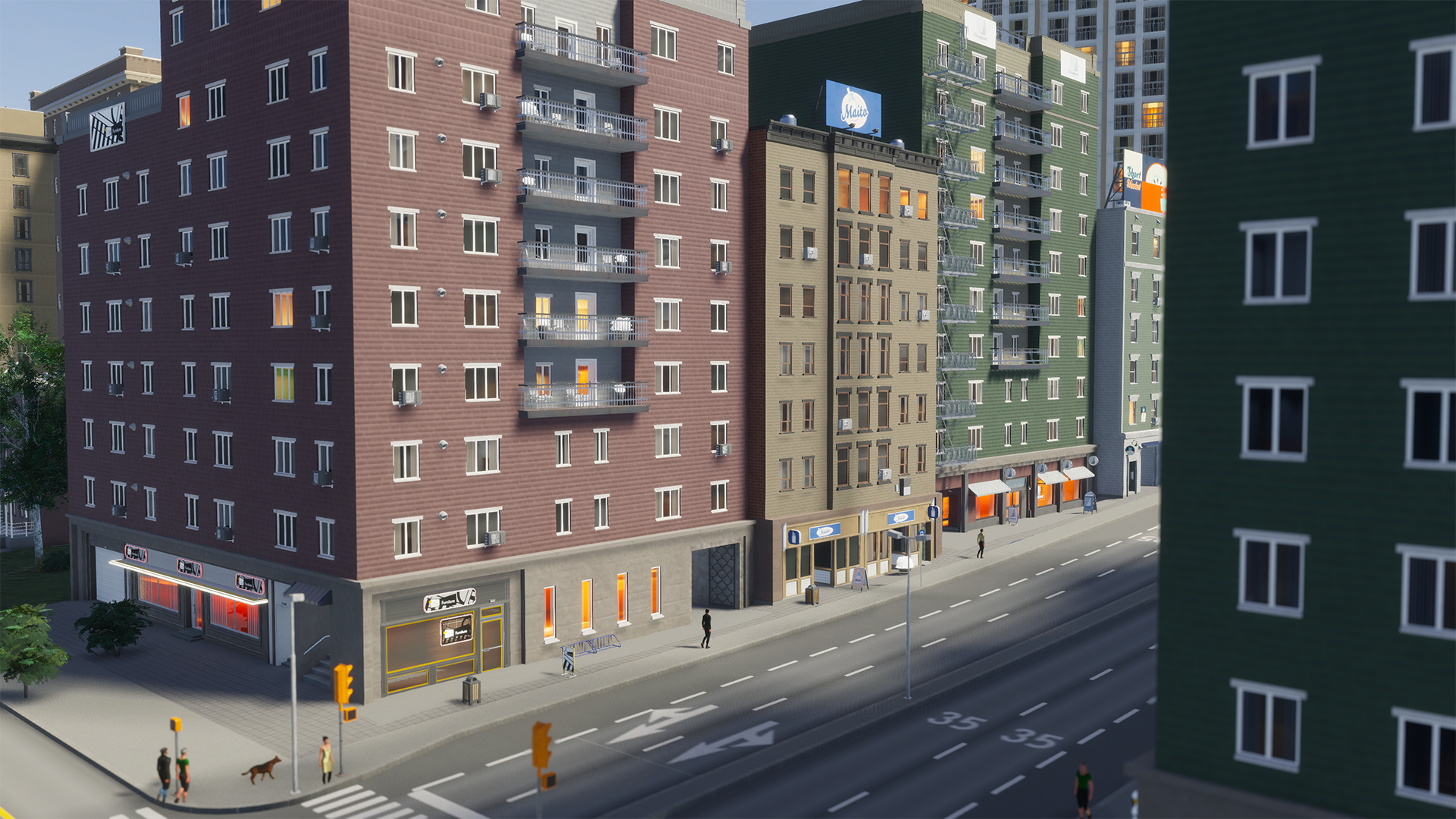
Satisfy your city’s residential and commercial demand by building mixed housing
Commercial Zones
Commercial zones feature low and high density buildings where companies sell all types of goods manufactured locally or imported from Outside Connections. This includes everything from cars and groceries to clothes and paper products, and they also provide the citizens with leisure options in the form of restaurants, movie theaters, bars, hotels, and more. Commercial zones thrive close to residential areas as they provide them with customers. The major differences between low and high density businesses, apart from their physical size, are the types of companies as well as the volume of goods they are able to sell to consumers. The low density businesses are usually boutiques, gas stations, small stores, and bars while the high density businesses tend to be supermarkets, department stores, and various recreational locations such as theaters and hotels. Small businesses employ fewer workers and can serve smaller amounts of customers, while large businesses on the other hand are populated with many employees and thus can service a greater number of people. This also means they are able to sell more goods from their stock compared to smaller, low density businesses.

Commercial businesses offer a range of goods and activities for your citizens to enjoy Commercial businesses benefit from local manufacturing as they have quick access to the goods they are selling. Local manufacturers also benefit from the nearby commercial companies as the transportation costs of manufactured goods to the retailers are low, allowing them to earn higher profits per sold unit.
Industrial Zones
Industrial zones are divided into manufacturing companies and warehouses. Manufacturing encompasses most of the industrial zones as factories and workshops while warehouses appear here and there, answering to the needs of the different companies and their production processes. Warehouses store produced goods that are ready to be shipped further but are still waiting for transport or suitable buyers.

Local industry can provide your commercial buildings with goods at a lower price and bring in additional tax income Industrial zones manufacture goods from materials that are either transported from Outside Connections by delivery trucks or extracted and processed locally in specialized industrial areas. Some goods are sold to commercial businesses who then sell them to customers (for example Food) while other goods are first sold to commercial businesses where they are further converted into products or immaterial goods (such as Beverages turned into Entertainment). Industrial zones attempt to sell goods to local buyers first. If there is overproduction of a type of goods the companies will ship the excess production to Outside Connections, but selling to the local market is always more profitable due to lower transportation costs. Continuing to sell to Outside Connections will further decrease the profit as they have to ship the goods further and further to new buyers, simulating the eventual oversaturation of the market. Companies in general seek to re-evaluate their business every now and then, adjusting the number of employees to match the current business landscape and market needs.

Warehouses appear mixed in with the manufacturing industry and provide additional storage for businesses
Office Zones
Similar to commercial zones, office zones are divided into low density offices with small office buildings and high density offices featuring glass-walled skyscrapers and office towers. Offices produce immaterial goods and services for private citizens and companies alike. Office companies convert technological goods manufactured in industrial zones into software and further into other immaterial goods such as telecom, finance, and media. Office zone companies include banks, electronics retailers, law firms, insurance companies, and telecommunications companies. Software is an important type of immaterial goods for both the industrial and office sectors as they produce various goods, however, software in itself isn’t sold to private customers. Other goods produced from Software, such as Telecom and Finance have a wider reach as private customers also benefit from them. Media is sold directly to citizens in the form of consumer electronics, video games, and such.

Both low and high density offices provide your city with useful immaterial goods
Zone Suitability
Each zone type has a Zone Suitability infoview which activates when you start zoning. Depending on the zone type, it shows pertinent information about which areas are suitable for the selected zone type. As an example, zoning commercial areas shows information about where the potential customers are located in the city while zoning a residential area highlights ground pollution so that it is easy to avoid when zoning. It also shows areas that might be otherwise unsuitable, perhaps due to high Land Value making rent for low density housing very high.
Zone Demand
City growth is largely based on the different zone types needing more space and the symbiotic relationship between them. New citizens move in and require housing which increases residential demand. The new citizens then need jobs and places to go shopping and spend their free time so industrial and commercial demand increases. As industrial manufacturing increases, they need places to sell their produced goods which also increases commercial zone demand. And as more companies are founded, more job positions become available which in turn increases demand for residential housing. Adjusting taxes for the different education levels as well as the various goods produced and sold in the city can have a great effect on local demand. Taxes can be used to favor different goods and products manufacturing in the city or simply give a helping hand to fledgling industries.
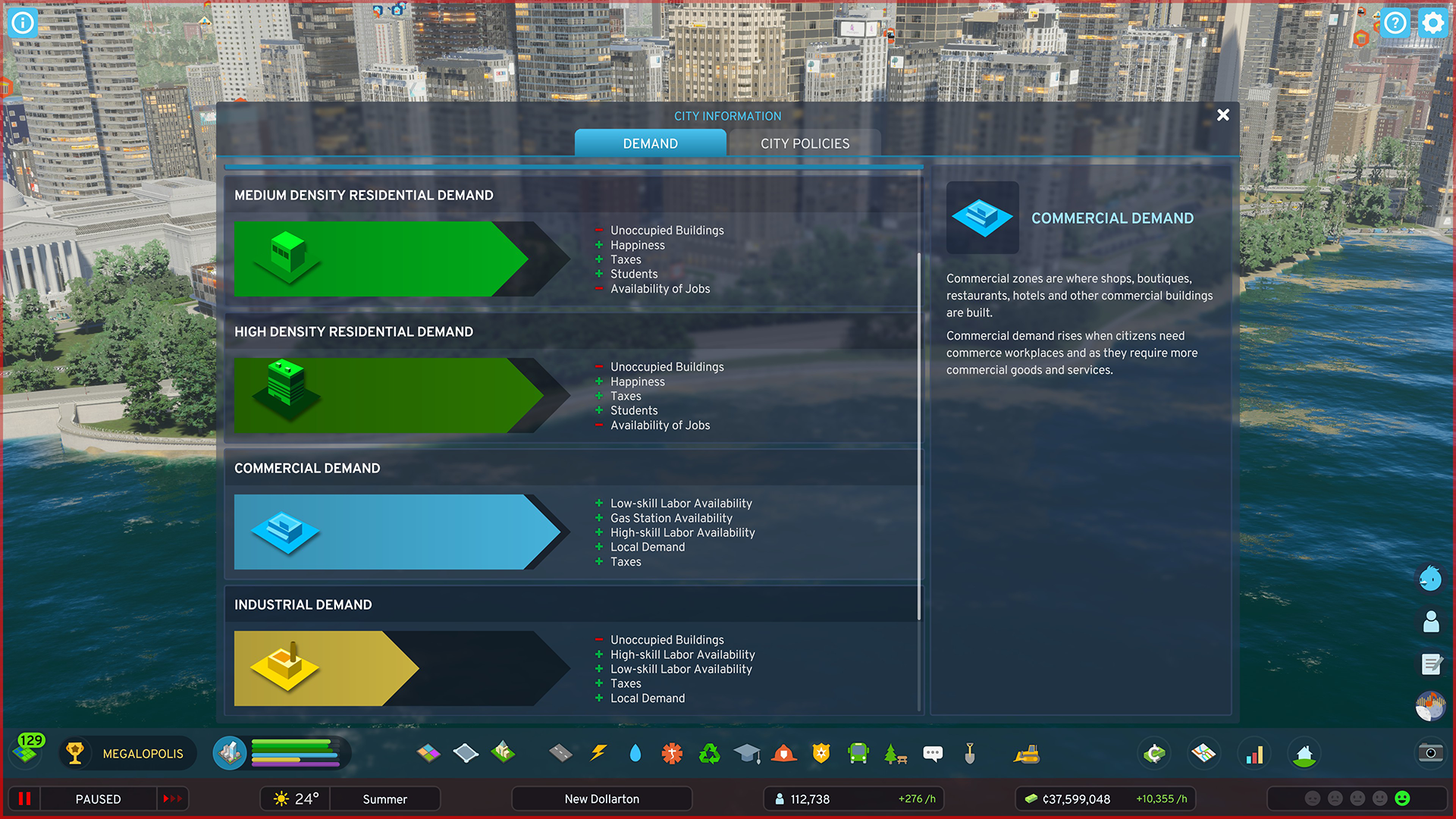
Additional details about demand can be found in the City Information panel
Residential Demand
Residential demand increases when new citizens want to move in: citizens moving in for work, students seeking education opportunities, or people simply wanting to move in because the city is an inviting location to raise their families. Families and seniors prefer large apartments, thus increasing the low and medium density housing demand. Single-person households and students don’t shy away from smaller apartments, favoring medium density apartment buildings and high density residential towers; the living costs are also divided among the high number of households, making living cheaper in these zone types.

Continue to expand your city to answer the demand for housing Residential zone demand also increases as jobs in the industrial, commercial, and office sectors become available. The zones require a workforce and as new workers move in, they demand suitable housing. When unemployment increases and jobs aren’t available, residential demand decreases until the issues are remedied. If the city has a large number of built but unoccupied homes, residential demand can decrease until the available homes become occupied.
Commercial Demand
Commercial zone demand is based on manufacturers producing goods for sale and the availability of potential customers, as well as citizens needing jobs. When industrial zones produce goods, they need to sell them to make a profit. As the local market is always a more profitable option, they want to sell their goods within the city which increases the need for local commercial companies. However, having goods and products to sell is only half of the business. The commercial zones also require enough purchasing power from the local citizens to not only survive but to flourish. Thus, local demand for goods and products is an extremely important factor in commercial demand. Citizens want to buy things for their households and they also simply want to spend time in their favorite leisure activities which include shopping.
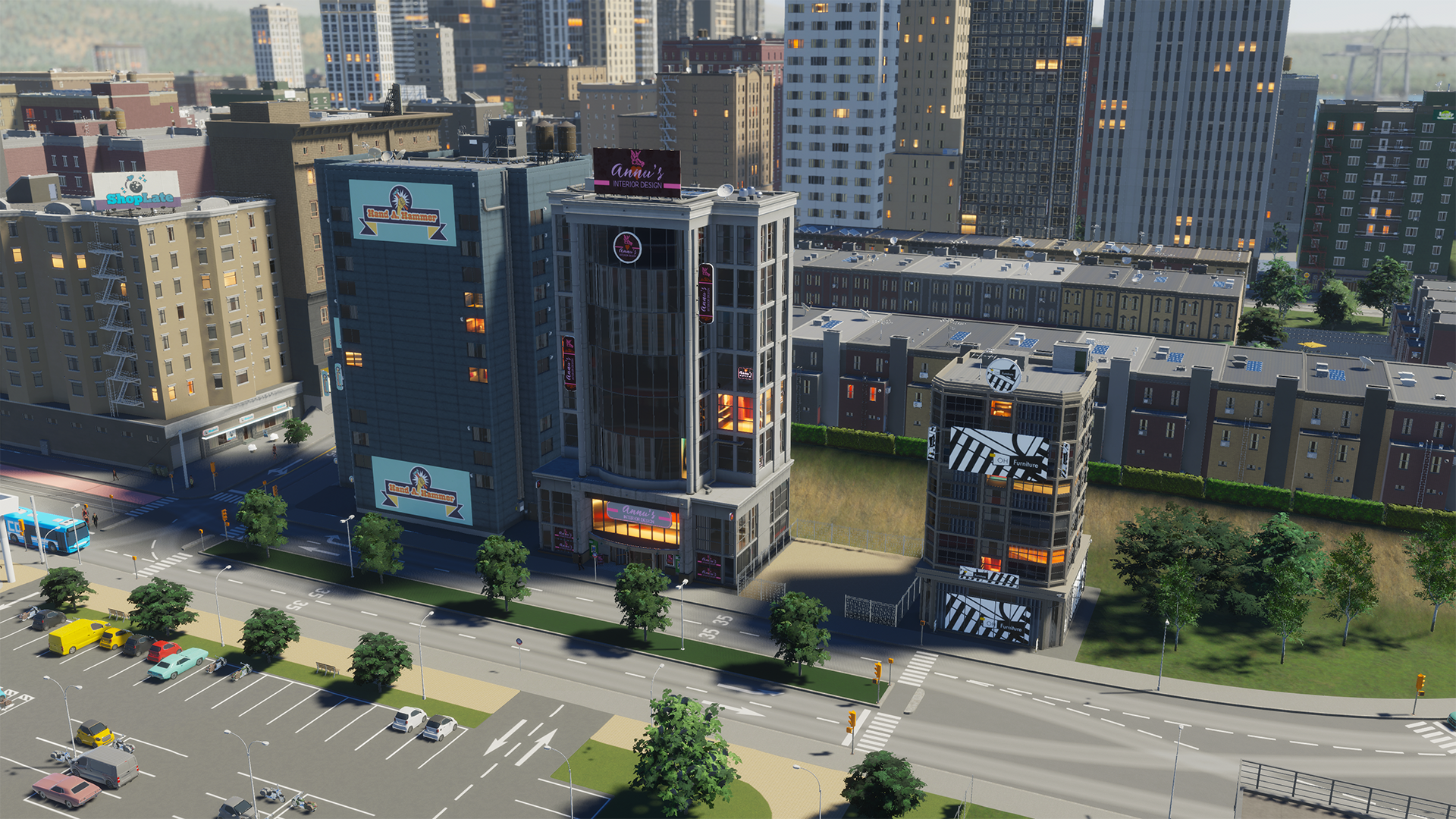
High density commercial buildings employ more people and can serve more customers Commercial demand also increases if companies detect the availability of a suitable workforce in the city. When companies have the needed employees to fill the required positions, their profitability increases.
Industrial Demand
Industrial demand is based on citizens needing jobs in the manufacturing sector as well as local commercial companies requiring goods and products to sell. The demand can be further increased by the availability of local resource extraction by specialized industries. Setting up specialized industrial areas provides materials for manufacturing locally, decreasing transport costs and thus increasing profits.

Extract resources locally to increase profits for industrial companies Worker availability is one of the cornerstones of industrial demand. Attracting new citizens to the city directly affects the demands of the various sectors, including industrial zones. As companies always seek to optimize their production, they are in search of suitable workers. As the companies increase in levels, their requirements shift to more educated employees; this leads to increased productivity and efficiency which in turn manifests in higher profits. Manufacturing also benefits from having local warehouses to store produced goods and products. Companies tend to have relatively small storage facilities and seek to sell all their products as quickly as possible. Warehouses allow more flexibility and time to seek suitable new buyers if no one is currently available, while still keeping production going.
Office Demand
Office demand is increased by citizens wanting to work in the office sector as well as citizens and businesses needing the various immaterial goods that offices provide. Manufacturing industry and other office companies benefit from the software developed in the office zones. As software is produced, more office companies appear as they can further develop the software into other services.
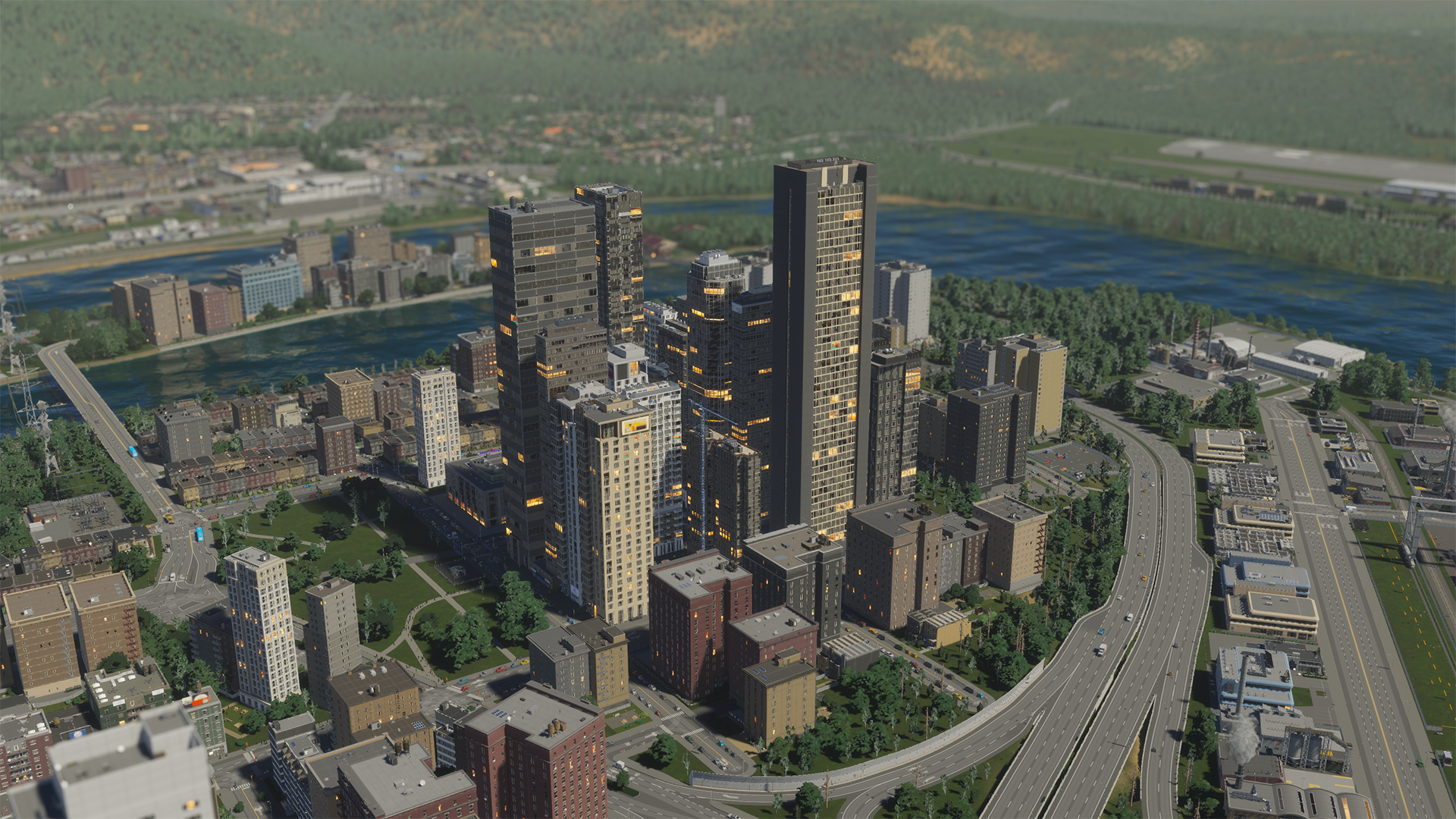
Create a central business district with tall office buildings Office zone demand also benefits greatly from finding suitable workers to boost productivity and efficiency in the companies. Similar to other companies, the better the workforce matches the needs of the companies, the more profitable they will be. Depending on the age range of the customers, different types of immaterial goods are preferred. Adults and seniors favor banking services and products from the financial sector while children and teens consume more media products.
City Specialization
Companies working with the same materials and producing similar products benefit from each others’ proximity. Industries and offices concentrate on areas where similar companies already exist; they communicate with each other and have a better chance to hire specialized workers to increase their efficiency. As more and more companies produce the same type of goods or products, they gain a city-wide specialization bonus which increases their efficiency and thus their profit. City specialization can be assisted by setting up specialized industry areas which harvest materials used by the companies gaining the city specialization bonus. Also, adjusting taxes to be favorable to those products and goods helps the industries develop even further!
Land Value and Building Levels
Land Value is a tool to understand which locations are desirable for citizens and companies, and it spreads through roads to the buildings’ close neighborhoods, slowly increasing the value of the area in general.
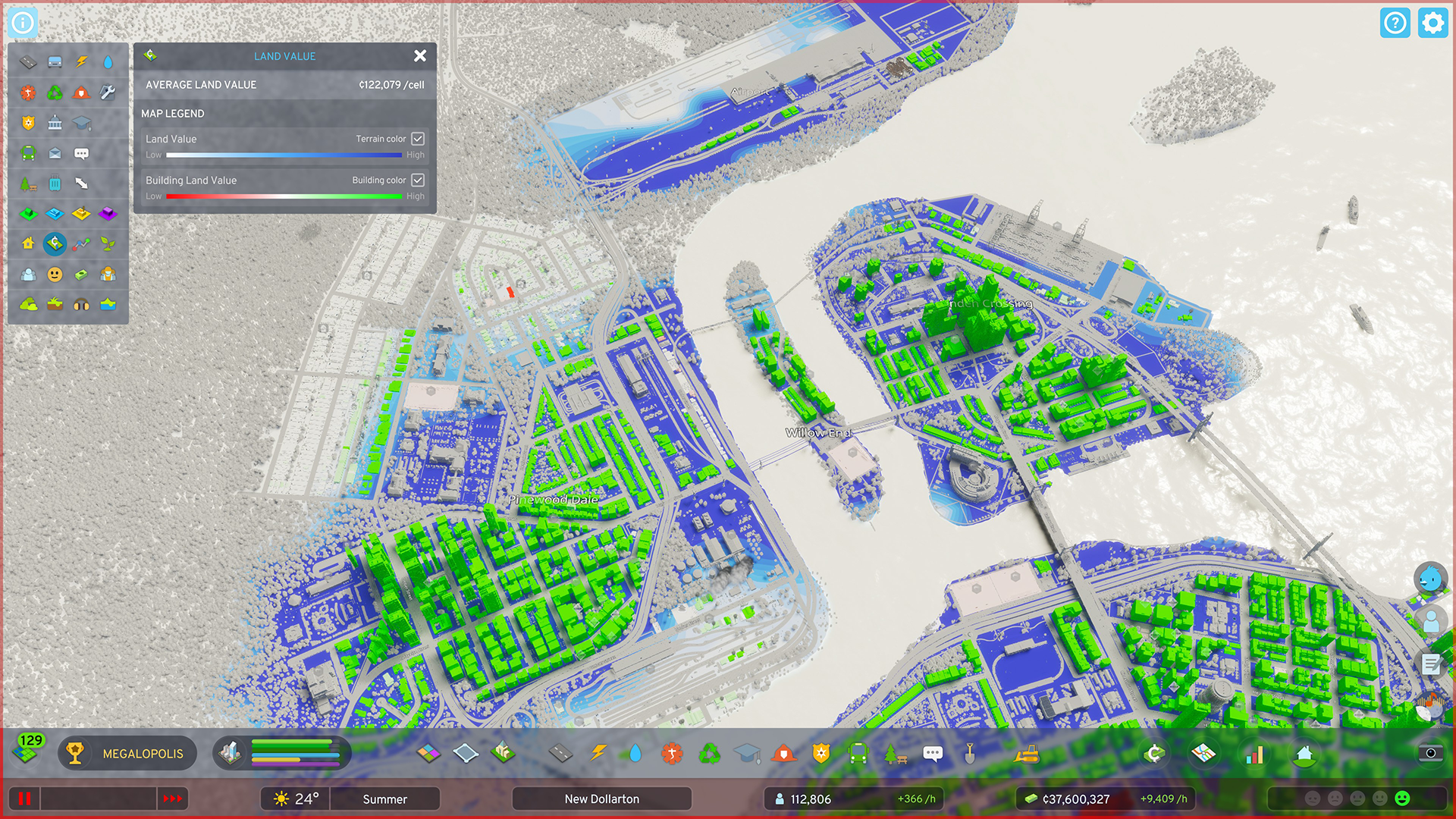
Areas with high Land Value are very desirable for citizens and businesses Citizens tend to value large homes, the proximity of shops, services they require, schools and workplaces as well as pollution-free locations. If the citizens find homes that suit their needs, they move in. And if they are happy living there and are wealthy enough, they are able to pay a higher rent which translates into an increase in the area’s Land Value. It is important to note that simply plopping all city services into a neighborhood doesn’t increase the Land Value in the area automatically. Only when the residents and companies have their needs met, be it with services or shopping options for citizens, customers, and resellers for companies, will Land Value be affected as the residents and companies feel that the area is valuable to their existence. If the rent is higher than the upkeep cost of the building, the residents pool their leftover funds into improving the building which eventually leads to the building leveling up. High demand for a specific zone type can also increase the rent and thus also the Land Value, as more people want to move into the city than there are places to live. To keep the Land Value in check (if needed) you can adjust the various residential taxes, encouraging or discouraging citizens to move in. Also, zoning more of those zone types with high demand can help keep the Land Value in check as the demand is met. It is also possible to simply limit the number of required services and leisure options to keep the Land Value low. Citizens can tolerate some shortcomings in regard to their needs and still live relatively happy lives. If the citizens are not able and willing to pay higher rent, the rent decreases which also affects the Land Value around the building. Residents will move out if the living costs are too high and they don’t feel like their needs are met in the area where they live, and some will even move out of the city. However, if the residents continue to not be able to meet the rent costs, the building will start to deteriorate as no money is used for the building’s basic upkeep. The residents then move out in greater numbers and the building becomes abandoned. This further decreases the Land Value. Abandoned buildings can become occupied by homeless citizens but due to the constant disrepair, the building will eventually collapse.

As Land Value increases citizens prefer smaller homes so they can afford their rent Land Value affects different residential zone types in different ways. Low density housing areas can quickly become expensive to live in as the Land Value increases. The higher Land Value affects the rent and since low density housing has only one household per building, the increased rent falls on the single household entirely. Thus, lower-income families tend to move out of these residential areas and search for new homes in medium density housing areas. Medium and high density housing areas are less affected by the increased Land Value as the living costs are divided among many dozen households. Many citizens prefer living in smaller homes that cost less than struggling to make their rent. Companies evaluate suitable locations for their businesses partially using Land Value and the size of the rent which is subtracted from the value of the company’s production. However, companies also take into consideration the location based on the material transportation costs. Companies pay for the transportation of materials to their location as well as the transportation of produced goods and products from the company to resellers and customers. The lower the transportation costs, the more suitable a location is for the company. Similar to residential housing, companies use any money leftover from covering the building’s upkeep costs to improve the building and eventually level it up.
Building Levels
All zoned buildings have Building Levels from 1 to 5. Building Levels represent the progression of the building from a lower to a higher quality building and are a reflection of how wealthy its inhabitants are. As the building increases in level, its upkeep increases which means that its rent also increases. In residential buildings electricity and water consumption also decreases per household and as the buildings change at levels 3 and 5, more apartments are available in medium and high density residential buildings. In commercial buildings, electricity and water used per one unit of goods or products sold decreases. Furthermore, commercial buildings are able to produce goods and services faster which means that they can sell them cheaper to consumers. This leads to citizens choosing higher-level commercial companies over other options. Similarly, in manufacturing and office buildings, electricity and water used to produce one unit of goods decreases. Higher-level buildings adopt better utility practices, boosting their production efficiency and also generating less garbage and pollution. Visually, buildings change at every other level, representing the increase in the quality of the building. Lower-level buildings have an intended “cheaper” look while higher-level buildings adopt a more modern and detailed look.
Signature Buildings
Alright, with zone types and demand covered it’s time to talk about signature buildings! These are a new feature in Cities: Skylines II and can best be described as unique, ploppable zoned buildings that fall into the familiar categories of residential, commercial, industrial, and office buildings. Each signature building has its own unlocking requirements such as the Sculptor Mansion having 3 requirements: reaching a certain Progression Milestone, attaining a specific citizen Happiness level, and having a number of cells zoned with low density residential housing. Once met, the building becomes available and can be placed anywhere on the map, similar to service buildings. The building is unique and can be placed only once but is entirely free to build. It can be relocated just like any other ploppable building and bulldozing it allows you to rebuild it again at a later date.
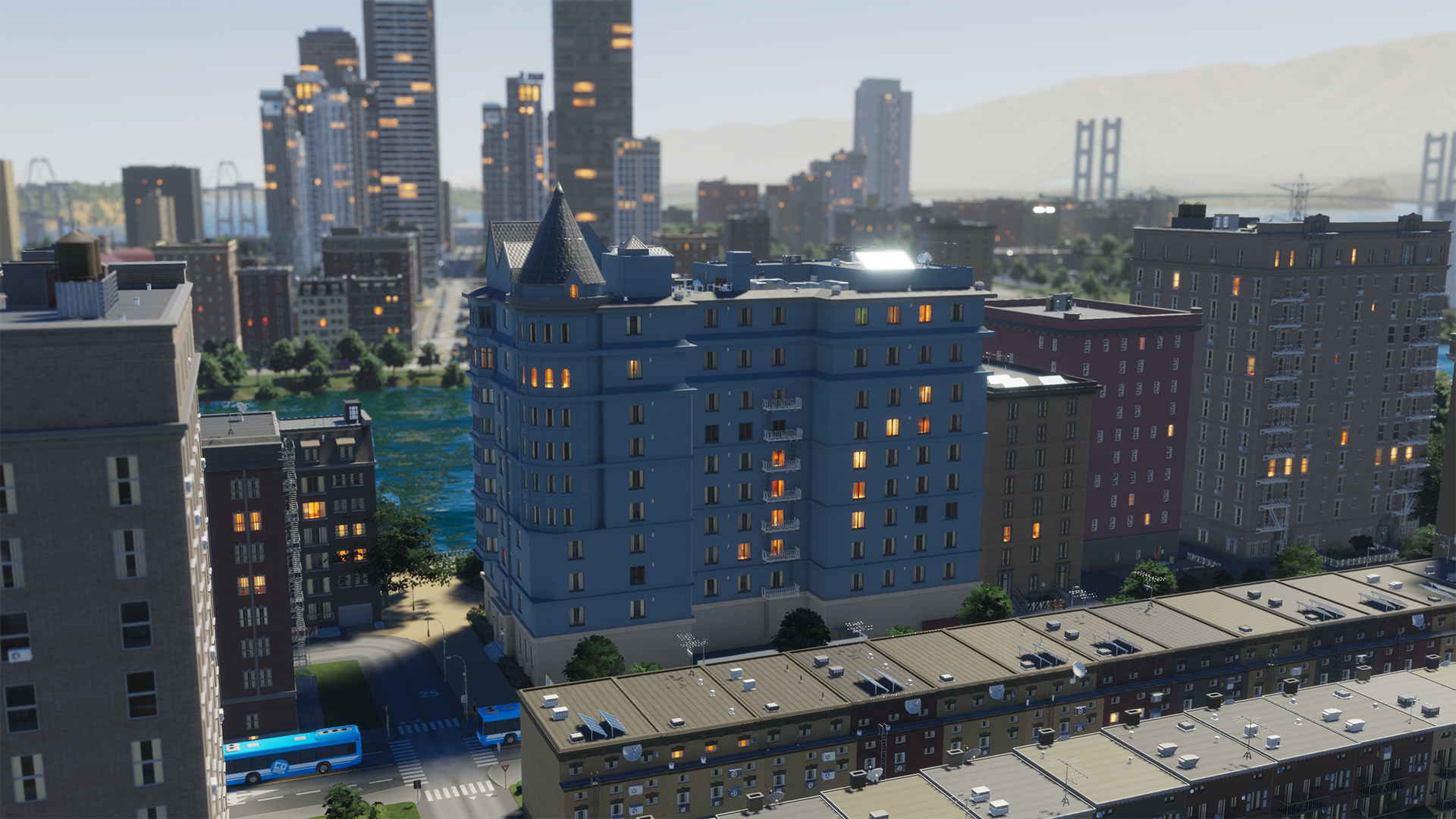
Residential signature buildings vary in size from mansions to medium density apartment buildings to residential skyscrapers Signature buildings function similarly to regular zoned buildings and contribute to the zone-based economic cycle. A residential building welcomes new residents while a commercial building, office, or factory seeks a suitable business to occupy it. The same laws of success and failure affect the companies residing in the signature buildings as any other business. They require a suitable workforce, compete for the same customers, and try to turn a profit to be successful.

Signature buildings allow you to build large commercial buildings, massive factories, or impressive offices which function like your zoned buildings Each signature building also has one or more positive effects. These range from effects affecting the neighborhood to effects that are city-wide. Some affect citizen Well-being and city Attractiveness for tourists while others improve the city’s entire industrial sector or boost high-level education effectiveness and more! Either way, they offer interesting new effects and options for your city.
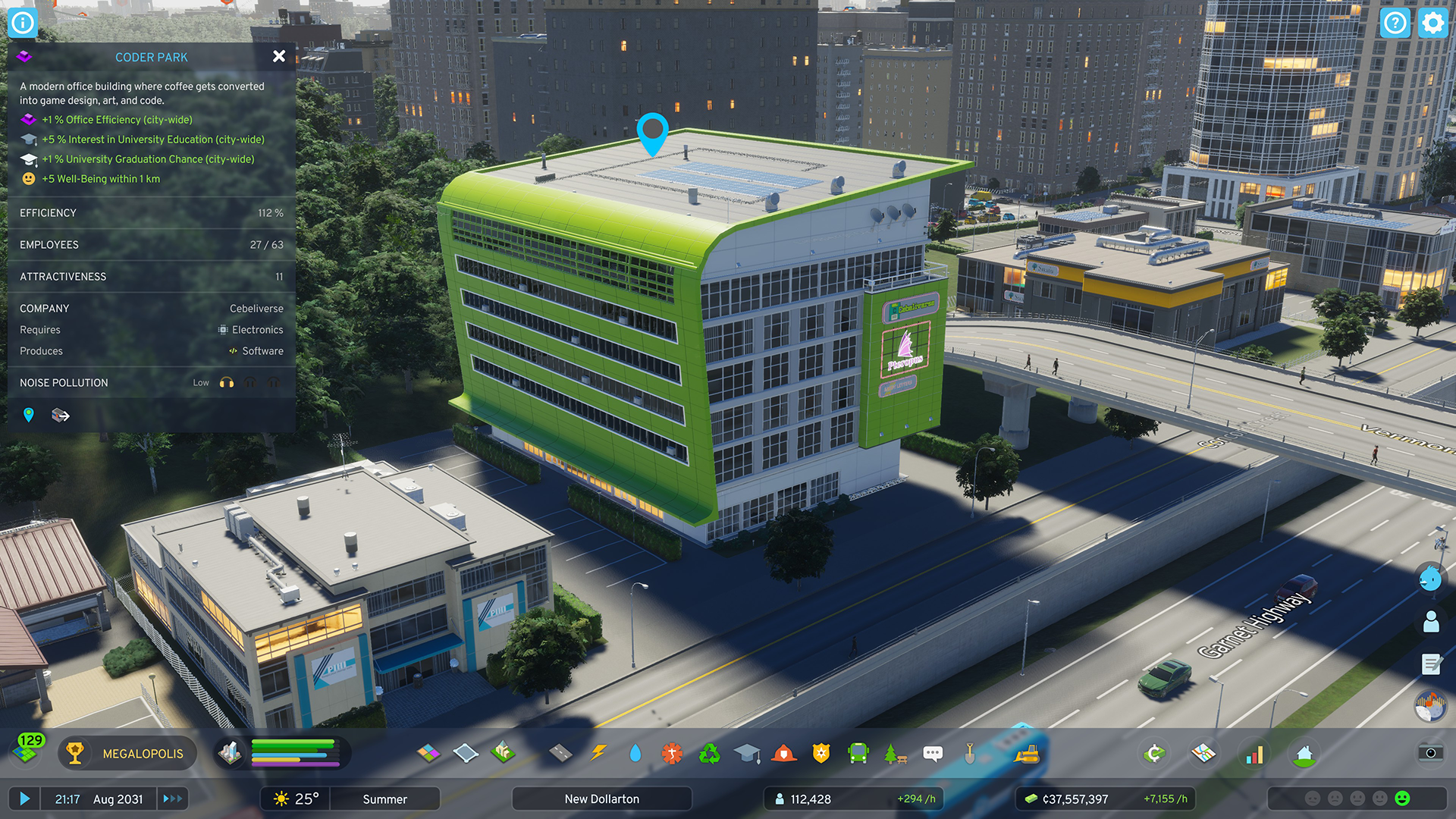
Coder Park provides both city-wide and local benefits This concludes today’s development diary. We hope this provides you with a good understanding how of zoning works in Cities: Skylines II with the addition of new zone types and signature buildings. Are you looking forward to incorporating medium density and mixed zoning into your cities? And what do you think about signature buildings? Let us know below. Next week we tackle the topic of City Services including both familiar and new options. We hope to see you then.









